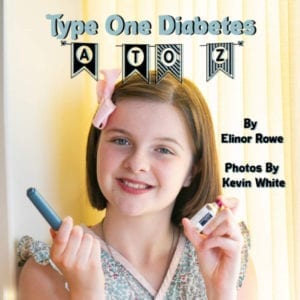
13 Sep 22 Diabetes Terms to Know
For the latest installment of 22 in ’22 (a series of quick takes, easy lists, and fast reads), we’re tackling T1D terminology. What could be more appropriate than the ABCs of diabetes as we head back to school? It’s also fitting since Type One Diabetes A-Z is Ellie’s alphabet book for young readers.
Now, we’re highlighting lingo and jargon (of which there is plenty) and breaking down the slang and acronyms we casually use (unintentionally making it harder to communicate directly about T1D).
How many of these words have you used this week? Did we leave any out? Our list is by no means comprehensive, but here are 22 Diabetes Terms to Know…

22 Diabetes Terms to Know
There are very few people who understand what type one diabetes (T1D) is, and even fewer comprehend the ins and outs of daily diabetes management. Until Ellie’s diagnosis, we had no idea.
I try to use words and phrases that anyone would understand, but occasionally I forget and lapse into T1D lingo. Ellie started at a new school. We were visiting with teachers during summer workdays to give them a heads up about her health needs, to let them know she would have a 504 Plan, and to communicate the emergency action plan for a severe low. We made a deliberate effort to ditch the jargon and use plain language.
Too often, I use words and phrases that are technical or have other meanings. Have you ever talked about losing a site and had someone misinterpret it as losing sight? Have you casually asked if your daughter is high and needs to test? Clearly, others might think drug use, but a T1D parent is talking about blood sugar.

Between technical terms and misconstrued meanings, communicating about T1D can be challenging, if not downright fraught with pitfalls. It’s ironic that communication about T1D, which can be tricky, is vitally important. How we explain T1D helps keep kids with diabetes safer.
When we were talking with teachers before the start of school and breaking down some of the most critical aspects of T1D, we became even more aware of the terms, slang, and acronyms we use, and we’re sharing our top 22…
1. A1C
A test that measures your average blood sugar control for the past two to three months.
According to the American Diabetes Association, hemoglobin is the part of a red blood cell that carries oxygen to the cells and sometimes joins with the glucose in the bloodstream. Also called hemoglobin A1C, the test shows the amount of glucose that sticks to the red blood cell, which is proportional to the amount of glucose in the blood.
2. Basal
A steady trickle of low levels of longer-acting insulin, such as that used in insulin pumps. Ellie thinks of it as background insulin.
3. Beta cell
A cell that makes insulin. Beta cells are in the islets of the pancreas.
4. BG
Blood glucose or blood sugar–the amount of blood sugar at a specific time.
5. Bolus
Insulin taken to cover an expected rise in blood sugar (blood glucose), often related to a meal or snack. When Ellie was first diagnosed, she remembered “bolus” and “bowl” to refer to her fast-acting insulin she took before eating. Quite simply bolus is the insulin you get for a meal or a correction for high blood sugar.
6. Brittle diabetes
Describes when blood glucose (BG) levels move in extremes from low to high and from high to low. Ellie describes this as a roller coaster.
7. Carbs
Grams of carbohydrate in a serving of food. Foods that provide carbohydrate are starches, vegetables, fruits, dairy products, and sugars.
8. Crashing
When blood sugar goes low quickly.
9. CGM
Continuous glucose monitor– This FDA-approved system tracks your blood sugar levels day and night. It helps detect trends and patterns that you and your doctor (see “endo”) can use to better manage your T1D. You need a prescription for the device.
10. Dawn Phenomenon
The early-morning rise in blood sugar level that may stay higher later into the morning.
11. Diaversary
The anniversary of diagnosis. Ellie celebrates life and the miracle of being on this earth! We aren’t throwing a party for diabetes (an uninvited guest), but we are honoring Ellie’s bravery and joyfully embracing life.
12. DKA
Diabetic ketoacidosis is a serious complication of diabetes that occurs when your body produces high levels of blood acids called ketones. The condition develops when your body can’t produce enough insulin. Without enough insulin, your body begins to break down fat as fuel. This process produces a buildup of acids in the bloodstream called ketones, eventually leading to diabetic ketoacidosis if untreated.
13. Endo
Short for endocrinologist, a diabetes doctor.
14. Glucagon
Hormone that can be administered to treat severely low blood sugar. Available in injectable form or as a nasal mist.
15. High–Hyperglycemia
High blood sugar (blood glucose); it happens when the body has too little insulin.
16. ISF
Insulin sensitivity factor (used to calculate correction doses)
17. Low—Hypoglycemia
Low blood sugar (blood glucose) of typically less than 70. Signs include hunger, nervousness, perspiration, dizziness, light-headedness, sleepiness, and confusion. Ellie says she feels “shaky.” If left untreated, a low can lead to unconsciousness. Hypoglycemia is treated by consuming a carbohydrate-rich food such as a glucose tablet or juice. We follow the rule of 15/15 (ingest 15 carbs, wait 15 minutes for BG to increase, and repeat until Ellie is back in range/above 70).
Severe low blood sugar is treated with an injection of glucagon (see definition above) if the person is unconscious or unable to swallow.
18. Meter
A glucose meter, also referred to as a glucometer, is a medical device for determining the approximate concentration of glucose in the blood.
19. MDI
Multiple Daily Injections– insulin therapy consists of three-four (or more) injections per day. This includes one injection of long-acting insulin in the evening and an injection of rapid or fast-acting insulin before each meal.
20. Pump
An insulin pump is a device roughly the size of a deck of cards that can be worn on a belt or kept in a pocket. An insulin pump connects to narrow, flexible plastic medical tubing that ends with a needle inserted just under the skin. Users set the pump to give a steady trickle or basal amount of insulin continuously throughout the day. Pumps can also release bolus doses of insulin (several units at a time) at meals and at times when blood sugar (blood glucose) is too high.
21. Site
A place under the skin in which you receive the insulin. An infusion set connects the insulin pump delivery device to your body, working the same way as an intravenous line does. A needle is housed inside a cannula (a tiny plastic tube that is usually placed under the skin in the subcutaneous fat). This needle is necessary to puncture the skin to insert the set. If the cannula bends or the adhesive anchoring the needle fails, we refer to as a “bad site,” and, as a result, Ellie’s insulin delivery is interrupted.
22. TDD
Total Daily Dose of insulin (basal + bolus).
Our thanks to the American Diabetes Association (ADA) for defining common terms. See the ADA’s more comprehensive list of diabetes definitions: https://diabetes.org/resources/students/common-terms.
As always, info provided does not constitute medical advice. This post is for general education and awareness purposes, and families should always consult with healthcare professionals regarding T1D treatment.



